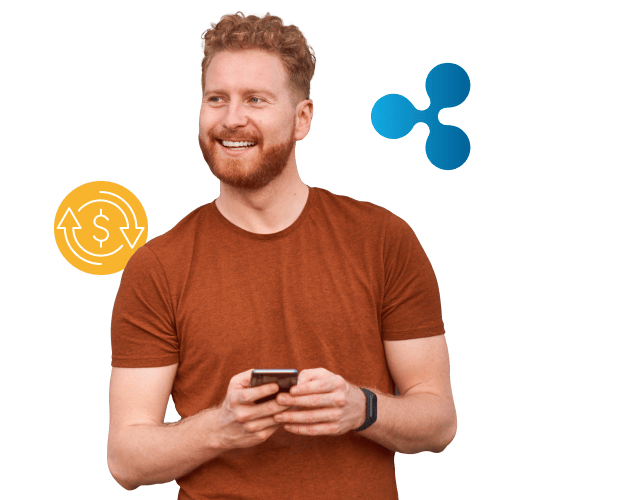Ripple has a long, extensive history, but there are still some misunderstandings about the XRP Ledger, which was built for cross-border payments. Discover more about Ripple and the problems it is solving within the traditional financial system, and learn about how this might impact the price of XRP.
What is Ripple (XRP)?
Ripple is a provider of crypto and blockchain solutions for businesses. XRP, on the other hand, is a digital asset built for payments. Ripple is a company that exists independent of XRP.
What is the XRP Ledger?
XRP Ledger is an open-source public decentralized blockchain. It was built specifically for payments – fast (~3 seconds per transaction), cheap ($0.0002 per transaction), scalable (1,500+ transactions per second), and is relatively carbon-neutral and has committed to being fully carbon-neutral by 2030.
XRPL uses Federated Consensus as the validation system, which requires 80% or more of the validators to agree to reach consensus. It was also the first public blockchain to have a decentralized exchange built in.

How does Ripple (XRP) work?
Ripple is a cryptocurrency-focused company that looks to utilise
Unlike most other cryptocurrencies, the XRPL does not rely on
What is Ripple’s relationship with XRP?
Ripple leverages XRP in its products and is one of many players building on the XRP Ledger – which is an open source, decentralized technology.
XRPL is an open-source technology that is native to Ripple’s tech stack. Ripple can’t control who builds on the XRP Ledger, lists XRP or governs (reverses) XRP transactions. Therefore, even if Ripple went away tomorrow, the XRP Ledger and XRP would continue on.
What makes Ripple (XRP) different?
Ripple’s focus on enabling fast and low-cost international money transfers is one of the elements that helps the company to stand out. While traditional cross-border transactions have historically been slow and costly, Ripple’s payment protocol aims to revolutionise this process.

By utilising the XRPL’s blockchain technology, Ripple provides a platform for banks, payment providers and other financial institutions to send money globally in a secure and efficient manner.
The XRP Ledger employs a unique consensus mechanism called the Ripple Protocol Consensus Algorithm (RPCA). Other blockchains rely on an energy-intensive mining process to create new coins or tokens, whereas the RPCA consensus algorithm uses a network of trusted validators to process and validate transactions. This approach significantly reduces the network’s environmental impact, while ensuring that the XRPL is fast and scalable.
Ripple’s native digital asset, XRP, is another of the protocol’s distinguishing features. Unlike other cryptocurrencies, XRP was not designed as a decentralised currency for individuals to hold or mine. Instead, it acts as a bridge currency within the Ripple ecosystem.
When using Ripple’s payment protocol for cross-border transactions, XRP serves as a liquidity intermediary, facilitating the instant transfer of value between different fiat currencies.
What is the Ripple (XRP) price and forecast for the future?
XRP’s price history has broadly followed the movements of the wider crypto market over the years. In 2017, the popularity of
| Year | Start Price | Mid-Year Price | End Price | Percentage Change |
|---|---|---|---|---|
| 2015 | – | $0.011 | $0.005 | – |
| 2016 | $0.005 | $0.007 | $0.007 | 40% |
| 2017 | $0.007 | $0.247 | $1.980 | 28,186% |
| 2018 | $1.980 | $0.465 | $0.351 | -82% |
| 2019 | $0.351 | $0.397 | $0.193 | -45% |
| 2020 | $0.193 | $0.241 | $0.220 | 14% |
| 2021 | $0.220 | $0.705 | $0.830 | 277% |
| 2022 | $0.830 | $0.332 | $0.339 | -59% |
| 2023 | $0.339 | $0.473 | $0.615 | 81% |
| 2024 | $0.615 | $0.476 | $2.080 | 238% |
Source: Investing.com
XRP’s primary use case revolves around fixing various inefficiencies within global banking and payment systems. If Ripple is able to position itself as a true competitor to traditional money transfer services, such as SWIFT, XRP could potentially witness significant price appreciation.
It is difficult to compare XRP to traditional cryptocurrencies such as bitcoin (BTC). Some XRP investors believe that it will become the primary currency within the remittance industry, with the value of the cryptoasset increasing accordingly. However, others are more dubious. Regardless, it is important that investors do considerable research before choosing to buy XRP.
“XRP can settle transactions on the ledger in 3–5 seconds. It was built to be a better Bitcoin — faster, cheaper and greener than any other digital asset.”
XRPL.org
Who created Ripple?
In 2011, David Schwartz, Jed McCaleb and Arthur Britto began developing the XRP Ledger. In 2012, the developers, alongside Chris Larsen, founded NewCoin, which was soon renamed OpenCoin, and then rebranded again as Ripple Labs in 2013.

The XRP Ledger was launched in 2012, followed by the completion and release of its native cryptocurrency, XRP. However, McCaleb left the company that year to create a rival network called Stellar (XLM).
Over time, Ripple has made significant enhancements to the XRP protocol to comply with regulations. In 2016, Ripple Labs obtained a BitLicense from the State of New York, a business license for companies completing activities with virtual currencies, thus boosting its integration into the traditional financial system.
In 2020, the XRPL Foundation, an independent non-profit entity, designed to help accelerate the wider adoption of the XRP Ledger, was launched. All of these developments continue to push Ripples case for it gaining greater mainstream acceptance, particularly from the US regulator the Securities and Exchange Commission (SEC)
Tip: In 2019, Ripple Labs purchased a 10% stake in international remittances company MoneyGram for $50 million.
Final thoughts
Overall, Ripple’s emphasis on fast, low-cost international transactions, its unique consensus algorithm, and the specialised role of XRP as a bridge currency help to set it apart from other cryptocurrencies.
These features position Ripple as a promising solution for the challenges faced by traditional financial systems, and by leveraging blockchain technology, Ripple strives to make global money transfers more accessible, efficient and secure, ultimately transforming the way we send and receive funds across borders.
Learn more about cryptocurrency on the eToro Academy.
FAQs
- What is XRP used for?
-
XRP is not intended to act as a medium of exchange, store of value or currency. Instead, XRP acts as a bridge currency that can be exchanged for any other currency on Ripple’s XRP Ledger. In addition , XRP is used as a spam prevention mechanism on the XRP Ledger.
- What is Ripple Labs?
-
Ripple Labs is a technology company that develops crypto solutions for businesses, financial institutions, governments and developers. It uses blockchain technology, including XRPL, to enable the fast, transparent and cost-effective movement of value around the world. It also helps customers to access crypto liquidity, tokenise value and implement Central Bank Digital Currencies (CBDCs).
- Is the XRP Ledger owned and operated by Ripple Labs?
-
No, the XRPL is not operated by Ripple. Each user of the XRP Ledger can choose their own validator list, and anyone can run their own validator node.
This information is for educational purposes only and should not be taken as investment advice, personal recommendation, or an offer of, or solicitation to, buy or sell any financial instruments.
This material has been prepared without regard to any particular investment objectives or financial situation and has not been prepared in accordance with the legal and regulatory requirements to promote independent research. Not all of the financial instruments and services referred to are offered by eToro and any references to past performance of a financial instrument, index, or a packaged investment product are not, and should not be taken as, a reliable indicator of future results.
eToro makes no representation and assumes no liability as to the accuracy or completeness of the content of this guide. Make sure you understand the risks involved in trading before committing any capital. Never risk more than you are prepared to lose.


